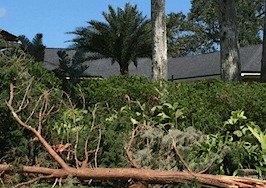- ATTOM Data Solutions analyzed 3,000 counties and 22,000 cities for their risk of earthquakes, floods, hail, hurricane storm surge, tornadoes and wildfires.
- California had the largest share of cities with 'very high' natural hazard risks.
- Agents should include natural hazard risk information in presentations for buyers so they won't feel blindsided if a natural disaster happens near their home.
The past month has been full of history-making Hurricanes — first Harvey, then Irma, and now Maria. The wicked wind, torrential rain and devastating floods these storms brought with them have caused billions of dollars in damage and have displaced thousands.
These hurricanes have sparked further conversation about climate change, with everyday folks and scientists alike zeroing in on the present-day impact of natural disasters on our cities and homes. As we look at our neighbors in Texas, Florida and the Caribbean work to rebuild their lives, many have begun to wonder: Am I next?
ATTOM Data Solutions has sought to answer that question in their 2017 Natural Hazard Housing Risk Report, which details the risk of earthquakes, floods, hail, hurricane storm surge, tornadoes and wildfires for more than 3,000 counties and 22,000 cities.
Among 50 U.S. cities included in the analysis with a population of 500,000 or more, those with the highest overall natural hazard housing risk index were Oklahoma City, Oklahoma; San Jose, California; Los Angeles, California; Bakersfield, California; and Seattle, Washington.
Oklahoma City tops the list with an index score of 111.7 due to a ‘very high’ risk of hail and tornadoes. The California cities of San Jose (63.10), Los Angeles (58.13) and Bakersfield (54.01) took the middle spots because of the ‘very high’ risk of earthquakes. Seattle (52.69), which shored up the end of the pack, also had a ‘very high’ earthquake risk (more on the latter risk can be found in a frightening New Yorker article).
Even when population size is taken out of the equation, 90 out of the 100 top cities with the highest overall natural hazard housing risks are in California.
On the other hand, Philadelphia, Pennsylvania (6.54); Phoenix, Arizona (7.51); Buffalo, New York (8.61); Orlando, Florida (8.94); and Brooklyn, New York (9.24) had the lowest overall natural hazard housing risk for cities with a population of at least 500,000.
When population size is taken out of the equation for the lowest risk areas, it seems that Michigan is one of the safest states to live in — Levering, Naubinway, Paradise and Mackinaw City have the lowest risk indexes, ranging from 0.8-0.10.
The city with the lowest overall natural hazard risk is Barrow, Alaska, with a “perfect” score of 0.00.
Natural hazards don’t keep homeowners away
Conventional wisdom might lead some to think the greater the natural hazard risk, the less desirable an area would be to a homeowner due to higher insurance rates or issues with appreciation.
But ATTOM’s analysis found that median home prices in cities that made the top 20 percentile for natural hazard risk have appreciated 65 percent on average over the past five years. Median home prices in cities that made the bottom 20 percentile, on the other hand, have appreciated at nearly half the rate (32 percent) over the same time period.

ATTOM Data Solutions Senior Vice President Daren Blomquist says the benefits these high-risk areas offer, such as access to good-paying jobs and other opportunities for growth, tend to outweigh any natural hazard risk.
“Strong demand for homes in high-risk natural hazard areas has helped to accelerate price appreciation in those areas over the past decade despite the potential for devastating damage to homes that can be caused by a natural disaster — as evidenced by the recent hurricanes that made landfall in Texas and Florida,” said Blomquist in a statement.
“That strong demand is driven largely by economic fundamentals, primarily the presence of good-paying jobs, although the natural beauty that often comes hand-in-hand with high natural hazard risk in these areas is also attractive to many homebuyers.”
High flooding risks are drowning home values
The only areas where the trend of higher appreciation for high-risk cities doesn’t hold true is in the flood-prone states of Florida and Louisiana.
Median home prices in Florida cities with the highest hurricane storm surge risk appreciated 47 percent over a five-year period, while median prices in cities with the lowest hurricane storm surge risk went up 67 percent over the same time period.
Median home prices in Louisiana cities with the highest flood risk have only appreciated by 2 percent since 2012 while median home prices in the lowest risk cities increased by 37 percent.
Blomquist says that although natural hazards aren’t usually the “deciding factor” for most buyers, it’s something that Realtors need to educate buyers about, especially if they live in an area prone to hurricanes, flooding, tornadoes, wildfires or hail.
“Agents and brokers who provide this information to homebuyers will bolster their credibility as a trusted advocate and also avoid resentful buyers who regret not being provided such information upfront before they read through the disclosures at the closing table or discover they are sitting on an earthquake fault line after moving in,” he said in an emailed statement.
“At a more macro level, those in the industry should be aware of evolving behavior among consumers, particularly when it comes to flood risk and hurricane storm surge risk,” he added.
“Although overall natural hazard risk does not appear to be weakening demand in high-risk areas, there is strong evidence in this report that demand is weaker in areas with high flood risk as well as areas with high hurricane risk — in both cases the high-risk areas have median home prices down compared to 10 years ago, counter to the overall market trend.
“For agents and brokers selling homes that are in high-risk flood zones or close to high-risk flood zones, it will be important to understand this is an increasingly important factor in those areas.”
See where your city ranks here.









